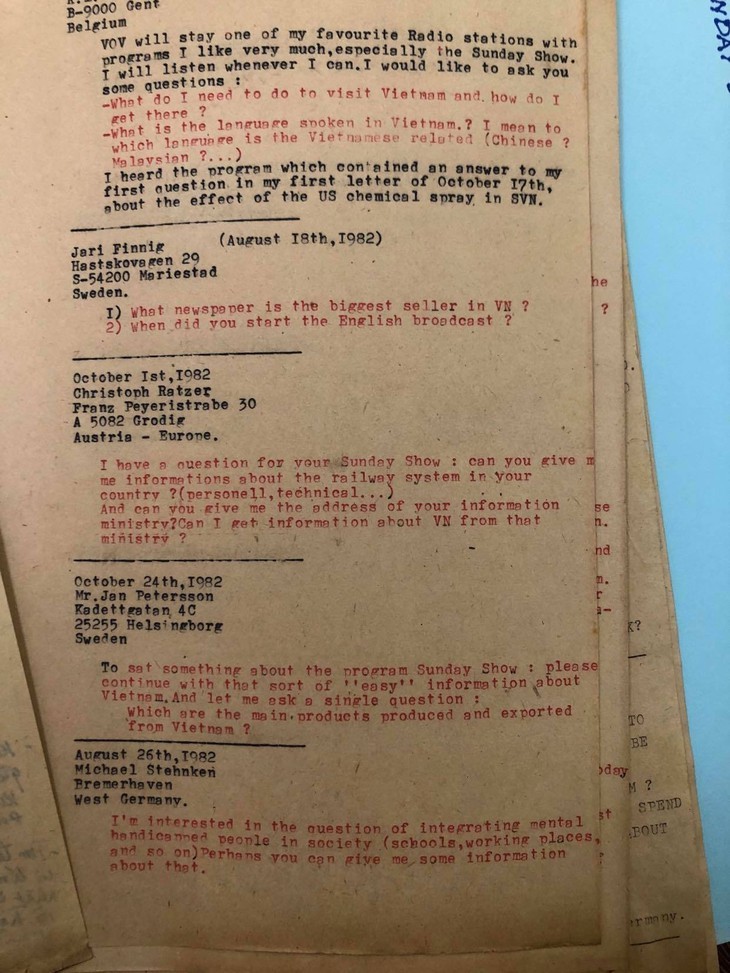 A record of listeners' letters to VOV A record of listeners' letters to VOV |
B: This week, Sanil Deep of India wrote: “Here is a letter from your old friend in India – a listener since the 1980s - once again. This is my regular monthly report for your station, which I hope will be useful to the technical department.”
A: He continued: “My day has started with the VOV programs for the past 41 years. The Letter Box is presented in such a way that it gives listeners a fully-entertaining program. This program also gives an opportunity for listeners and broadcasters to learn about each other every week. I’m still enjoying the Sunday Show with all the songs on the program.”
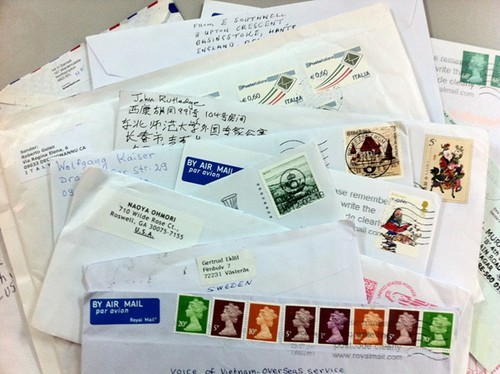 Listeners' letters to VOV Listeners' letters to VOV |
B: Mr. Sanil asked whether cinemas in Vietnam have opened yet.
A: No, I’m sad to say. Recently, film and television production companies have sent a request to the Prime Minister seeking to resume operations. They haven’t received approval yet due to the COVID-19 pandemic.
B: Another Indian listener Shivendu Paul listened to VOV on 2,3,4,6,7,9 of November on the frequency of 7220 khz and received good reception at UTC 1600-1630. He wrote: “I listened and read different news stories about world events from Voice of Vietnam. Vietnamese Prime Minister Pham Minh Chinh affirmed Vietnam's strong commitment to achieve net-zero emissions by 2050 at COP26 in Glasgow, the UK. On November 11, we organised a live discussion event called ‘Live from Glasgow’, using an online platform. After that, we organized an audio video presentation or film making contest on the topic ‘Climate Change and its remedies-our responsibility’ in English, Hindi, and Bengali.”
A: Thank you, Shivendu Paul, for sharing what you’ve been up to with your club in India. Vietnam’s strong commitment to climate change response has received international applause.
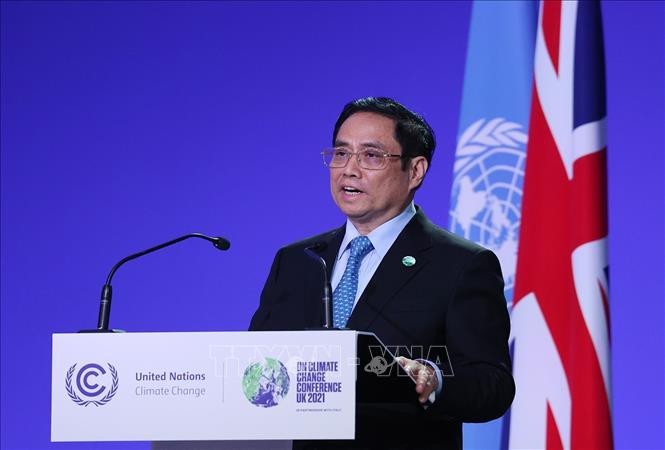 Prime Minister Pham Minh Chinh speaks at the 26th United Nations Climate Change Conference of the Parties (COP26), in Glasgow, the UK. (Photo: Duong Giang/VNA) Prime Minister Pham Minh Chinh speaks at the 26th United Nations Climate Change Conference of the Parties (COP26), in Glasgow, the UK. (Photo: Duong Giang/VNA) |
B: Claire Stockwell, a climate policy expert at Climate Analytics, has praised Vietnam’s signing of the Global Coal to Clean Power Transition Statement at the 26th United Nations Climate Change Conference of the Parties (COP26) in Glasgow, the UK. Stockwell emphasised that Vietnam’s approval of the coal elimination agreement is a huge step that deserves to be welcomed.
A: Many of the UK’s newspapers, including the Financial Times, the Guardian and the Independent, have reported Vietnam’s commitments to net zero by 2050 and to phase out coal power between 2030 and 2040.
B: Vice Chairman of the Vietnam-UK Network Paul Smith said Vietnamese Prime Minister Pham Minh Chinh’s speech at COP26 was positive and well received.
A: William Young, an environmental security expert at the Council on Geostrategy, said Vietnam’s commitments at COP26 have opened people’s eyes around the world about what the leadership of Vietnam is achieving in its fight against climate change, as well as the opportunities for economic growth.
B: Ratan Kumar Paul of India listened to VOV on November 8 from 16:05 to 16:30 on the frequency of 7220 khz and give us SINPO of all 4s.
A: Siddhartha Batachajee of India gave us a reception report for the program on November 14, from 16:00 to 16:30 UTC on the frequency of 7220 Khz. This week, he asked about Vietnam’s biggest television network.
B: Vietnam Television (VTV) is Vietnam’s biggest television network. Founded in 1970, VTV is a government agency with a broadcasting network covering all of Vietnam. It can provide services via satellites in most areas globally.
A: It has 6 nationwide free-to-air channels, 5 regional free-to-air channels, and hundreds of pay TV channels with more than 120,000 hours of broadcasting free-to-air channels. There are over 15,000 hours of satellite broadcasting annually.
B: With nearly 4,800 staff, the station has 5 regional bureaus and 8 overseas bureaus.
A: This week, VOVWORLD received nearly 350 letters and emails from 34 countries and territories around the world.
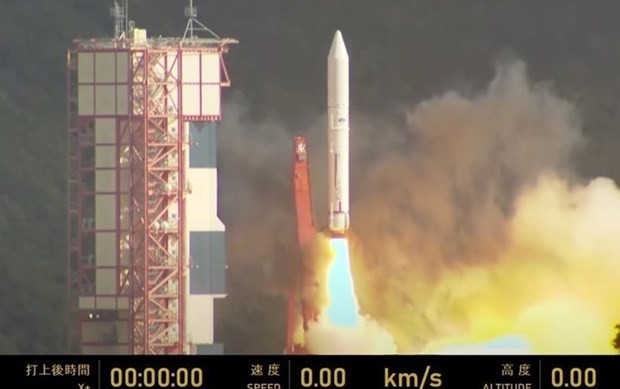 Vietnam’s NanoDragon and 8 other small satellites of Japan are sent to orbit from Japan, November 9, 2021. (Photo: JAXA) Vietnam’s NanoDragon and 8 other small satellites of Japan are sent to orbit from Japan, November 9, 2021. (Photo: JAXA) |
B: Many listeners of the Spanish program congratulated Vietnam on its successful launch of the NanoDragon satellite into outer space. Sergio Carrazana Wilson of Chile wrote: “This is great motivation for Vietnam’s development in association with scientific advances.”
A: Javier González Nungaray of Mexico wrote: “Vietnamese people can be delighted and proud of their new height with the successful launch of a satellite into the space serving the technological development in the country.”
B: Many other listeners of VOV shared their interests in Vietnamese cuisine and asked for Vietnam’s winter dishes.
A: In winter, we have a long menu of dishes that will surely make you warm on cold days. But the most popular is hotpot.
B: Depending on the region and culture, food in Vietnam varies and brings its own unique flavor. Hotpot is not a traditional dish but it is very popular in Vietnam from the North to the South.
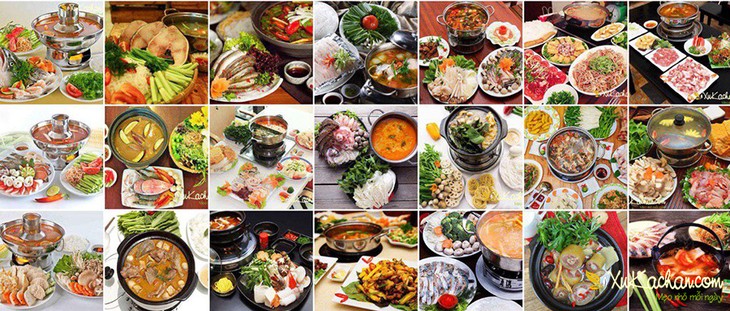 In Vietnam, hot pot comes in many forms. In Vietnam, hot pot comes in many forms. |
A: In Vietnam, hot pot comes in many forms. Every region of the country has its own specific kind of hot pot. For example: the North’s field crab hot pot, the South’s red tilapia hot pot, and Central Vietnam’s sour and spicy seafood hot pot all have entirely different palates.
B: Field crab hot pot is an appetizing dish in northern Vietnam. This dish has many different flavors to enjoy: the sweetness of crab meat, the buttery flavor of crab-roe, the sour of tomatoes and tamarind. It also has the savory flavor of dill, water spinach, and crab cake. You can add some other ingredients into the hot pot to feed your appetite. Some examples: flower crab, squid, shrimp, clam, or other kinds of vegetables such as buffalo spinach or water mimosa.
A: Field crab hot pot is not only popular in northern Vietnam but also beloved in the South. This delicious hot pot appears as a common meal for people in the area and even on the menu of luxurious restaurants.
B: Sour and spicy seafood hot pot of the central province of Thua Thien-Hue province has a very specific taste. The process of making this kind of hot pot is similar to Thai hotpot with the same raw ingredients such as clam, shrimp, squid, beef, and fish.
A: However, the broth of Hue’s hot pot is made in a special way with dried shrimp, dried squid, and a giant perch’s spine. Those ingredients are mixed with salt, sugar, tamarind sauce, and fish sauce. The combination of sour, spicy, salty, and sweet in this creates is a distinctive experience. When the broth boils, the raw ingredients are put into the pot along with mushrooms, water spinach, shallot, water dropwort, and cilantro. After the simple and fun process of cooking, you can enjoy a special dish from central Vietnam.
B: The South’s red tilapia hotpot is certainly unique. Red tilapia is commonly raised in the Mekong Delta. Red tilapia meat is white, firm, fatty, and delicious.
A: In the broth of this hot pot, there are small spring onions, tomatoes, water dropwort, and ginger. When the broth boils and is seasoned, the fish can be put into the pot. Red tilapia is ready to be served quickly and easily. This kind of hot pot is served with vermicelli. Usually, every eater has a small bowl of fish sauce on the table to dip red tilapia meat in. Red tilapia hot pot smells delightful and tastes awesome.
A: Vietnamese hot pot dishes are good for your health. They are one of the best choices for warm and friendly gatherings. With a hot pot and its fantastic smell, occasions like family reunions and meetings with friends are even more joyful and meaningful.
B: Hopefully you will soon have the opportunity to taste our hotpot when Vietnam resumes international flights. Until then, stay safe and healthy. Goodbye!